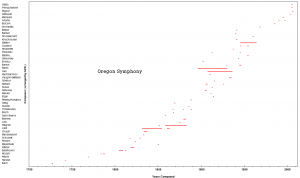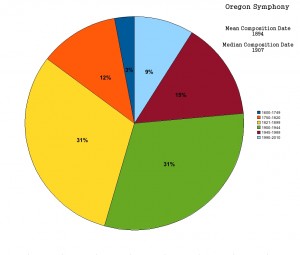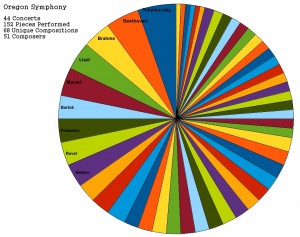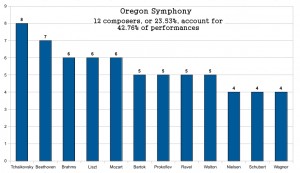The Oregon Symphony, based in Portland, represents the upper range of community orchestras in this survey. Since they began recording in the 1980’s their notoriety has increased, even leading to a Grammy nomination in 2003. I like their sound, and their connections to the local community. Their $15 million budget seems silly next to CSO’s $60 million, but that’s just the reason I’ve selected them here. I believe them to be at the top of their class. To be honest, I don’t really know anything else beyond that, so let’s look at the numbers!
A healthy coverage I think. Good to see some 1980’s and 1990’s in there. You can see the focus areas, but the spread seems nice enough.
To me, this distribution seems the most indicative of what people (paying people, that is) want to hear. While nearly half of the music is pre 1900, The other half is pretty well-rounded. The median composition date is higher here too. In fact it is the highest seen so far.
This is a thing of beauty! They’ve managed to program 68 pieces with 51 composers. This is the real metric that should be looked at closely. While the number of compositions-to-concerts is more of a time and money relation compositions-to-composer is a programming consideration. 1.33 compositions per composer means less bulking up on one or two big names. Even Walton gets a shot at the top 10 here! Compare this one ratio to the other orchestras and you’ll see the difference. CSO: 1.74, PO: 1.79, LSO: 2.14 (!). In the case of the London Symphony Orchestra, their Beethoven/Haydn/Nielsen series cripples their ratio, but perhaps the situation isn’t quite as dire as it looks (however even with those concerts removed, the ratio is still 1.93).
Now for the best part.
Beautiful. We have finally done away with the “superstar composer” in this chart, and while 1/5 of the composers still represent 2/5 of the music, that leaves a solid 3/5 for the others to fight over. With the large gaps removed between composers, it also more clearly reflects the idea that a popular composer probably should be played more, just not outrageously more. Sadly, there are no living composers in the top 12 spots.
So four major orchestras have been examined. Now, what can be said of all these charts and graphs? Well, there are a few things for sure, anyway.
1. Bigger orchestras can afford the commissioning of new music. This is a no-brainer, but it’s why orchestras like the CSO are important. Their gigantic budget helps fuel new orchestra music, which is an increasingly expensive art form. After these pieces are premiered they should, ideally, trickle down to smaller orchestras. That shows in the coverage maps, at the very end where 2010 versus 2009 or 2008 is apparent.
2. Risk takes money. Again, this should be obvious. The CSO can present a new music concert if the community seems to want it. The turnout might be lower, the reviews poorer, but it can be done. A smaller symphony must hedge their bets: if Beethoven and Tchaikovsky will fill the house then by golly we’ll play it until their ears bleed!
3. Orchestras and conductors have their favorites. In looking at the various seasons, each orchestra touts their own “special series” or “featured composer”, or maybe as in the LSO/Richard Strauss situation, there’s just favoritism. It could be from the conductor, the creative director (often the same as the conductor), the big donors, the community, or maybe the orchestra just has a tradition. Whatever the reason, a little favoritism is fine, so long as it doesn’t drown out the other composers. And really, is Beethoven-Mozart-Tchaikovsky really everyone’s favorite? Why not be creative? Why not say, “Hey, I know a really great little-known composer and I’m going to make it my thing.” Maybe it’s our education system focusing too much on the big players (bottom-up), maybe it’s the demand from the patrons (top-down), perhaps neither, but it’s a question I’ve been dying to know the answer to for years. Especially as conductors are increasingly separating from the orchestra and moving around during the season, this could bring insight and variety. (Incidentally, this article discussing conductor Marin Alsop’s passion for Brahms came out while I was writing this post.)
4. Composition is not the same as it used to be. While researching the compositions, I often came across bold statements to the effect of such-and-such symphony was “written during a single week in 1887” or whatever year. Look, that just doesn’t happen anymore. Some pieces, of course, but to the best of my knowledge and in talking with any of my friends working as composers, a large scale orchestral composition is a long and demanding process. The modern composer is often his or her own editor, copyist, and publisher. In one sense, the idea of commissions for larger work is still the same, but they take longer and cost more than ever. Furthermore, to fully leverage the musical possibilities afforded by the times, and to distinguish oneself creatively from the mass of other composers requires far longer than a week. Symphonic form was a cookie-cutter approach that is no longer welcome.
5. Variety is dead in the realm of concertos. Going through the lineups you see the same three instruments for every concerto: violin, piano, cello. The occasional trumpet concerto, or horn concerto, and I recall a flute concerto, will pop up, but they number one against dozens. What happened to everyone else?! Is it really necessary to hear 10 piano concertos in a season, with no clarinet, oboe, soprano? Oregon Symphony is performing Jennifer Higdon’s percussion concerto, god bless them, but there is a serious lack of solo music being performed for the majority of instruments. This is the kind of nonsense that is fueling auditions for violin positions with over 80 candidates. Concertos are a wonderful opportunity for the orchestra as well as the audience, but it sickens me how little notice is paid to the other orchestral instruments. Hell, there are even concertos for saxophone and orchestra, didgeridoo and orchestra, WATER and orchestra! This is an area that needs some honest improvement.
6. The 1970’s were a bad time to write music. Check out the coverage map that combines all four orchestra seasons into one:
Am I to conclude that nothing of value was written during the 1970’s? What was going on then in art music that makes those works so untouchable now? Maybe it was the minimalism, the experimental sounds, or maybe everyone was just burnt out from having too much fun in the 1960’s, arguably one of the coolest decades in music. Of course, we have only examined four orchestras, and it’s quite likely that the line would be solid red from 1600 to 2010 if enough data was accumulated.
Now for some of my more opinionated conclusions.
7. Orchestras are out of touch. They’re trying, really they are, but when the London Symphony Orchestra has a phenomenal recording of a Ein Heldenleben I’m far less inclined to want to hear it in concert (excepting, perhaps, a concert by the LSO). But I would absolutely love to hear things I haven’t heard before. There’s always room for the classics, but they’ve been around for 400 years, so I’m sure you can skip a few here and there each season. Or at least, something in addition to raw sound needs to be offered to the audience. When I see Of Montreal live, it’s to see a show, and I get it every time. Orchestras can’t really do that, but when you’re paying $60 to sit in the nosebleed section of the concert hall there really isn’t any “added value” to your seeing the orchestra perform live. There is no magic there. Even the concert hall can serve as a lure for music lovers. Consider the Disney Concert Hall, with its stunning architecture and rich acoustics. Or Portugal’s Casa da Música with similarly innovative architecture and acoustics. Each time I go to the CSO’s Symphony Hall I am appalled at how they are made to sound but, that’s just me, and I know it’s a statement that others will contest.
8. Contemporary music must be more satisfying for the performers. Look, I’m a French horn player. Give us Tchaikovsky, Mahler, Shostakovich, Wagner, and we’re in heaven. The members of the orchestra are an additional force that must be considered in programming matters. Can they play it? Some orchestras lack the experience to adequately tackle the orchestral footballs of Bruckner. Mahler can require dozens of extra players, increasing costs and crowding a small stage. But they also have to enjoy what they do, and sadly a lot of contemporary music can be problematic and less fun. I won’t name any names, but I’ve listened in on rehearsals at Florida State with some of the most sought-after composers of the day, and witnessed all sorts of stupid stuff. Parts not printed properly, flute notes not even in a range playable by the instrument, musical directives both vague and verbose, and material that just fails to ignite the players enthusiasm. Is it the role of the composer to make the orchestra feel really great about the music? No, but it’s a practical consideration that will affect the performance come concert time. Musicians are trained listeners, but still just listeners, and appreciating music is not the same as enjoying it.
So what about the CSO? My research proved to me that, while there exists some new music, a lot is left to be desired. Am I being greedy? The CSO has 54 composers in their season. But for 400 years of music… We have the power, we can digitize everything. We can explore the history of western music with tweezers or a snow shovel. It’s a matter of choice, money, taste, and curiosity.
I support my city’s orchestra, but first and foremost I support new music. So no season passes this year, but I’ve got my eye on a handful of concerts that I think I will enjoy immensely.
(By the way! The CSO kicks of their season this Sunday, September 19th at the JPP in Millenium Park. It’s a program that I would never pay for, but it’s amazing how much more enjoyable things are when they’re free. More info here.)
(One more thing: If you think public domain recordings of classical music played by professional musicians is something you would like to support, Musopen is currently accepting donations in their fund raiser for the next 20 hours. The project has already exceeded the initial goal by more than $40,000 and I think you’ll agree it’s a brilliant effort. Please consider donating.)
Notes
For each orchestra in the analysis, I wrote down all of the composers and found their birth years. Then I wrote down each of the unique compositions from the season and found their composition dates. Sometimes a single year was all that was available. The majority of this information is available on Wikipedia and is decently documented. I really couldn’t be bothered to use a stricter source for this project, and I didn’t worry because the worst case would be a piece spanning the lifetime of the composer, which still wouldn’t affect my results too much.
After all of that information was compiled, I ran the data through a short program that I wrote in Processing, an open source graphics framework that uses Java to do all sorts of great things. I used a library called gwoptics to set up a basic graph to plot the years. I wrote another program to draw the single line coverage maps.
In a spreadsheet I compiled the compositions and their years to break them down into bins. Adding a chart is easy after that. You might notice a silly little error in the choice of 1821 as the start for that bin. It should have been 1820, but I forgot to change it before compiling all of the graphics. As far as I can tell, based on the data it would have no impact whatsoever. I’m a busy man, so I left it as is.
The other charts were constructed similarly. I went through each season and for every piece I gave one tick to the composer, per concert. My selection of concerts was fairly specific: plain old orchestra concerts only. No pops, no chamber music, no “Eric Whitacre conducts his music” type events. These were not concerts that I was interested in anyway.
One of my favorite sites to visit is Information is Beautiful. The amazing visualizations there are an inspiration. Unfortunately, their influence stops about there, as my visuals are neither stunning nor elegant nor creative. In fact, David McCandless specifically states, “My pet-hate is pie charts. Love pie. Hate pie-charts.” Oh well. However, they simply display what the season brochures list in text, and I think they go a long way towards quantifying the types of music played by the modern orchestra.
To compile the data for these four orchestras took several hours. I had planned on including the LA Philharmonic, but their season is very large! Fortunately, as the “master list” of composers and compositions grew I was able to reuse my information here and there, saving time. Want to help expand this study? It’s easy! Just find an orchestra, download their official 2010-2011 season brochure (almost every orchestra has a pdf version available somewhere), and start gathering data. Make sure to check the master lists to avoid wasting time finding information already known. When you get the information you can run it through the visualizer programs (just download the Processing application and gwoptics library), or just send it back my way. I’ll even keep this Google document up to date with the most recent additional information that can be used to save time when collecting data.
For contributors as well as people who just want the data already collected, here is a zip file with everything. The format of files should be apparent. Feel free to email me with any questions about the data or the decisions I made while compiling it.
So that’s the end of a rather long adventure. There are likely many more useful and useless conclusions that can be gleaned from the data presented. I hope you’ve enjoyed reading, and I hope you’ve started to think about your own position in relation to contemporary performances of art music, but most importantly I hope that you choose to encourage your local orchestra to feature more music written in the last 20-40 years.
Have you hugged a composer today?
If you missed either of the first two parts in this series, just use the links below. Or perhaps you’re just feeling nostalgic. They’re there for that too.
Part 1: A Brief Introduction, and the Chicago Symphony Orchestra Part 2: The Philadelphia Orchestra and The London Symphony



